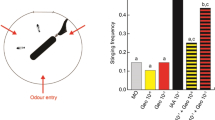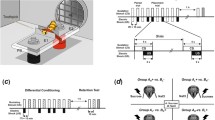Summary
The effect of temperature in the chemical defense of bombardier beetles is examined on the basis of toad glossopharyngeal nerve responses to tongue stimulation with either bombardier beetle defensive discharges or artificial stimuli of variable temperature and quinone content. The results indicate the following:
-
1.
Responses to bombardier beetle discharges (Fig. 1) are characterized by short latency (11–23 ms) and rapid attainment of maximum amplitude (within 100 ms). Response amplitude diminishes sharply within 400 to 700 ms, leaving a long-lasting (greater than 1.6 s) low level response. Repeated stimulation destroys general tongue sensitivity.
-
2a.
Responses to artificial stimuli all begin with a brief mechanoreceptive response to the impact of the stimulus droplet (Figs. 2, 3 and 4). The latency of this initial response component is less than 8 ms; maximum response amplitude is reached between 12 and 15 ms after stimulus onset.
-
2b.
Responses to unheated water aerosols contain only this initial response component (Figs. 3 and 4a); they end within 50 ms of stimulus onset.
-
2c.
Responses to hot water aerosols show a second component in the interval between 30 and 200 ms after stimulus onset (Figs. 2 and 4). The maximum amplitude and breadth of this response — but not the time of maximum amplitude — change with increasing stimulus temperature (Fig. 4). Repeated stimulation does not measurably diminish tongue sensitivity.
-
2d.
For unheated quinone stimuli (Fig. 3), the second response component begins sooner and lasts longer (i.e., more than 1.6 s) than it does for hot water stimuli, but there is no difference between the two stimuli in the time at which maximum amplitude is reached. Repeated stimulation with quinone destroys tongue sensitivity.
-
2e.
Responses to hot quinone stimuli show an increase in the amplitude of the first 50 ms of the second response component which exceeds that to be expected from a summation of independent thermal and chemical responses (Fig. 3). A synergistic action of temperature in facilitating sublimation and spread of quinone is believed to explain this effect.
-
2f.
Synergism of temperature and quinone is no longer evident after the first 50 ms of the second response component. On the contrary, the maximum amplitude of the second peak in responses to hot quinone approaches the sum of responses to hot water and unheated quinone in only one toad species (B. marinus, Fig. 3c and d). InB. americanus (Fig. 3a and b), maximum response amplitude is similar for hot quinone, hot water, and unheated quinone.
-
2g.
Responses to hot quinone aerosols (Fig. 3) are similar to responses to bombardier beetle defensive discharges (Fig. 1) except for the presence of the initial mechanoreceptive response.
-
3.
It is concluded that the evolutionary advantages of the hot defensive discharge rest primarily on its synergism of quinone effects and on concomitant advantages of the discharge mechanism. The role of heat as a primary deterrent is thought to be of secondary importance.
Similar content being viewed by others
Abbreviations
- psi :
-
pounds per square inch
References
Aneshansley, D.J., Eisner, T., Widom, J.M., Widom, B.: Biochemistry at 100°C: Explosive secretory discharge of bombardier beetles (Brachinus). Science165, 61–63 (1969)
Clarke, R.D.: Food habits of toads, genusBufo (Amphibia; Bufonidae). Am. Midl. Nat.91, 140–147 (1974)
Dean, J.: Predator-prey interaction between toads and bombardier beetles: A behavioral and neurophysiological study. Ph.D. Thesis, Cornell University (1977)
Dean, J.: Stimulator for producing small, heated aerosols. Physiol. Behav.23, 583–584 (1979a)
Dean, J.: Defensive reaction time of bombardier beetles: An investigation of the speed of a chemical defense. J. Chem. Ecol. (in press) (1979b)
Dean, J.: Encounters between bombardier beetles and two species of toads (Bufo americanus, B. marinus): Speed of prey-capture does not determine success. J. Comp. Physiol.135, 41–50 (1980)
Dodt, E.: Schmerzimpulse bei Temperaturreizen. Acta Physiol. Scand.31, 83–96 (1954)
Eisner, T.: The protective role of the spray mechanism of the bombardier beetle,Brachynus ballustarius Lec. J. Insect Physiol.2, 215–220 (1958)
Eisner, T.: Chemical defense against predation in arthropods. In: Chemical ecology. Sondheimer, E., Simeone, J.D. (eds.), pp. 157–217. New York: Academic Press 1970
Eisner, T., Meinwald, J.: Defensive secretions of arthropods. Science153, 1341–1350 (1966)
Hardy, J.D.: The pain threshhold and the nature of the pain sensation. In: The assessment of pain in man and animals. Keele, C.A., Smith, R. (eds.), pp. 170–201. Edinburgh, London: Livingstone 1962
Kimura, K.: Effects of temperature on the response of chemoreceptors in frog tongue. Kumamoto Med. J.15, 73–82 (1962)
Kraning, K.K.: Heat conduction in blackened skin accompanying pulsatile heating with a xenon flash lamp. J. Appl. Physiol.35, 281–287 (1973)
Norris, D.M., Chu, H.M.: Chemosensory mechanism inPeriplaneta americana: Electroantennogram comparisons of certain quinone feeding inhibitors. J. Insect Physiol.20, 1687–1696 (1974)
Sato, M.: Gustatory response as a temperature-dependent process. In: Contributions to sensory physiology. Neff, W.D. (ed.), pp. 223–252. New York: Academic Press 1967
Schildknecht, H., Holoubek, K.: Die Bombardierkäfer und ihre Explosionschemie. V. Mitteilung über Insekten-Abwehrstoffe. Angew. Chemie73, 1–7 (1961)
Walsh, LF., Halpern, B.P.: Digitally controlled summator for quantizing multiunit responses. J. Appl. Physiol.37, 748–751 (1974)
Yamashita, S.: Chemoreceptor response in frog as modified by temperature change. Jpn. J. Physiol.14, 488–504 (1964)
Author information
Authors and Affiliations
Additional information
I thank Drs. T. Eisner and B.P. Halpern for providing laboratory facilities and useful criticism in the course of this study, and also Drs. D. Aneshansley, T. Eisner, D. Forsythe, B.P. Halpern, and G. Wendler for reading manuscripts. This study was supported in part by the National Institutes of Health (grant AI-02908, to Eisner), the National Science Foundation (grants BMS-74-16084, to Eisner, and BNS-74-00878, to Halpern), and the Ford Foundation (Cornell Six-Year Ph.D. Program).
Rights and permissions
About this article
Cite this article
Dean, J. Effect of thermal and chemical components of bombardier beetle chemical defense: Glossopharyngeal response in two species of toads (Bufo americanus, B. marinus). J. Comp. Physiol. 135, 51–59 (1980). https://doi.org/10.1007/BF00660181
Accepted:
Issue Date:
DOI: https://doi.org/10.1007/BF00660181




